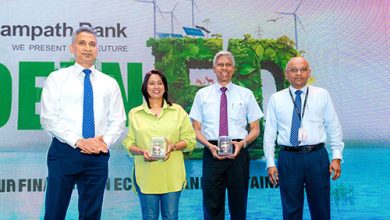DFCC BANK PLC
Post-Crisis Prosperity: DFCC’s Prins Perera Sheds Light on Industry Strategies in the Wake of Sri Lanka’s Economic Rebound
In the wake of Sri Lanka’s economic recovery, banking institutions are adapting strategies to align with the evolving landscape. Prins Perera, Senior Vice President of Treasury and Investment Banking at DFCC Bank PLC, discusses the proactive measures and innovative approaches the industry has undertaken to safeguard liquidity, ensure profitability, and identify promising sectors for investment. This interview highlights how financial strategies are critical in sustaining and capitalising on Sri Lanka’s economic resurgence momentum.
How does Sri Lanka’s economic recovery trajectory influence investment strategies and treasury management within the banking sector?
Sri Lanka’s economic recovery trajectory significantly impacts investment strategies and treasury management in the banking sector. The Sri Lankan economy has been steadily recovering, progressing from a sharp GDP decline of -7.82% in 2022 to -2.3% in 2023. This positive trend continued into the first quarter of 2024, with Sri Lanka reporting a GDP growth of 5.3%. The economy faced challenges from subdued economic activities and factors arising from the aftermath of the pandemic crisis.
Market liquidity has been negative approximately by LKR 200 Bn during 2022 and 2023, partly due to CBSL’s sale of dollars to the government to finance foreign currency debts and due to the movement of funds from local banks to foreign banks during the crisis period. The stabilisation of the USD/LKR exchange rate at 325 levels towards the end of 2023 and continued appreciation, coupled with social and political stability, led to an increase in the inflow of USD from tourism and worker remittances. Consequently, market liquidity began to improve due to the above factors as foreign banks engaged more actively in the interbank market and opened limits for the local banks. The Central Bank of Sri Lanka also intervened by purchasing dollars to bolster the country’s foreign currency reserves.
Improved market liquidity brought the market interest down with multiple effects compared to the policy rate cuts. AWPLR dropped approximately by 20% from 29% to 8.78%. Policy rates were reduced only by 7% during the same period. This was partly due to the finalisation of domestic debt restructuring and improved economic activities. However, the drastic drop in the AWPLR and market interest rates has caused the Bank’s Net Interest Margin to shrink, making it challenging for the treasury to safeguard the Bank’s profitability. Additionally, low credit growth during the last few years ( -0.6% in 2023 and 0.15% YTD in 2024) prompted banks to explore alternative income sources, such as investment in government securities, unit trusts, fee-based services, and cost-efficiency measures. Further, last year’s excess foreign currency liquidity in the banking sector prompted banks to explore foreign currency investment opportunities, such as investment in US Treasuries.
All the above factors have resulted in Banks’ treasuries being the main contributors to their bottom line (profitability), and they are growing.
In Sri Lanka’s post-crisis economic landscape, which sectors offer the most promising returns for bank investments and why?
In Sri Lanka’s economic landscape after the crisis, government securities have been favoured for their high returns over the past two years. However, new investment opportunities are emerging as the economy continues to recover.
While private sector credit growth remains subdued, money supply continued to expand throughout 2023 and the first half of 2024 (MoM +0.72%, YoY +8.34%, YTD +1.75%). Opportunities in leasing, pawning, and renewable energy are showing promise for lending. Despite banks experiencing growth from these sectors, gains were offset by negative credit performance in industries such as construction, pharmaceuticals, and fertilisers due to repayments from the government. We anticipate a rebound in the construction sector following the completion of external debt restructuring and the resumption of infrastructure projects in Sri Lanka.
The tourism sector is also on a path to recovery, although banks are cautiously extending facilities. Given the limited domestic lending options, banks are also exploring opportunities for lending overseas, both to foreign entities and Sri Lankan companies with international operations.
Considering the evolving economic landscape, what innovative treasury management approaches are banks adopting to balance liquidity needs with investment opportunities during Sri Lanka’s recovery phase?
Even though USD liquidity was a challenge during 2021-2022, post-bankruptcy USD inflows increased for the reasons below, supporting essential imports and primary economic activities.
Sri Lanka’s trade deficit stood at USD 2.17 Bn, for the first five months (from January to May 2024). Despite a trade deficit in the first five months of 2024, the current account surplus continued to expand. This surplus was primarily driven by an 86% increase in tourism earnings and a 12% year-on-year growth in worker remittances. Worker remittances reached USD 2.6 billion, while tourism earnings amounted to USD 1.4 billion.
The mentioned developments contributed to a rise in USD liquidity within the market, prompting banks to pursue additional avenues in foreign currency lending and investment in innovative products.
Moreover, the IMF has forecasted positive credit growth of 7.7% for 2024. However, achieving this target appears challenging, necessitating treasuries to take the lead in preserving Banks’ margins. As mentioned, treasuries seek alternative investment opportunities, including US treasuries, corporate debts, and avenues generating fee-based income, including trade, to sustain profitability.
Given the current uncertain and volatile interest rate environment, which is significantly influenced by upcoming elections, it is crucial to maintain a balanced approach between short-term and long-term investments. This strategy is essential to managing unforeseen liquidity needs effectively and protecting capital from potential adverse impacts resulting from fluctuations in the fair value of treasury investments.
How is DFCC Bank optimising its investment and treasury management strategies to navigate and capitalise on Sri Lanka’s economic recovery?
DFCC Bank has taken several steps to optimise its strategies. In response to the high interest rates, the Bank financed its long-term assets through short-term liabilities, expecting a downward trend in the market interest rates without locking into higher long-term liabilities. At the same time, the Bank delayed Tier II fundraising until the market interest rates were settled after finalising Domestic debt restructuring. These decisions were crucial for maintaining growth and ensuring sufficient capital for loan book expansion.
We strategically invested a significant portion of the Banks’ investments in government securities, which achieved a high return of 30% when loan growth was low. The bank liquidity ratios measured by NSFR, LCR, and Liquid asset ratios stand well above the regulatory requirements. These performances were well above the minimum thresholds related to the banking industry.
We also ventured into investing in US treasuries and expanded into other overseas markets where lending opportunities are available. Additionally, we invested in the equity market in 2024, seeing the corporate and NBFI industry growth prospects.
DFCC Bank is proactively positioning itself to capitalise on emerging opportunities while maintaining robust liquidity and capital ratios. These strategies are vital for sustaining the Bank’s stability and growth.






